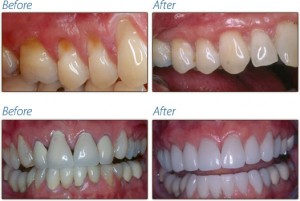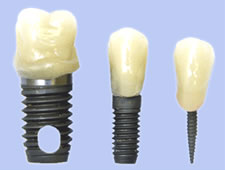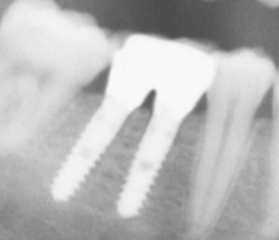Over the past 20 years dentistry has seen a dramatic increase in the use of dental implants. What was once an “experimental†or unproven treatment modality is now supported by an extensive research base. The vast majority of dental implant research is centered around the use of endosseous implants for replacement of missing teeth. Recently, the application of implants for use in other specialties has been explored. Previously, the use of dental implants within the specialty of orthodontics was limited to integration of implants into treatment plans strictly to facilitate tooth replacement. The orthodontic treatment that has traditionally been involved in treatment plans including dental implants has been limited to creating space or aligning roots for subsequent placement of implants. The use of dental implants as a direct adjunct to orthodontic treatment has been more limited until recently, but the potential exists for implants to play an important role in enhancing successful treatment outcomes. Continue reading
Tag Archives: Dental implant
Sinus lift surgery
A sinus lift is surgery that adds bone to your upper jaw in the area of your molars and premolars. It’s sometimes called a sinus augmentation. The bone is added between your jaw and the maxillary sinuses, which are on either side of your nose. To make room for the bone, the sinus membrane has to be moved upward, or “lifted.” A sinus lift usually is done by a specialist. This could be either an oral and maxillofacial surgeon or a periodontist. Continue reading
Mechanical Requirements of Dental Implants
Surface properties is the main reason for the use of titanium in medical technology. However, mechanical properties like elasticity and density/strength values are an additional clear advantage of titanium over other metals, because the supported or replaced natural structures of the human body are normally even more elastic and lightweight than titanium. Continue reading
Questions to Ask Your Periodontist Before Dental Implants
Dental implants are becoming an increasingly popular option for replacing missing teeth. Traditionally, dentists have relied upon bridgework or dentures to replace teeth that have been lost. Implants have advantages over other methods but are more expensive. Ask your periodontist if dental implants are the right choice for you.
Is your implant dentist a board certified specialist? Continue reading
Healing Dental Implant Surgery with PRP
Grafting has been used in Periodontal therapy and implants as a mean to reestablish the loss periodontal apparatus (alveolar bone, periodontal ligament, and cementum). Connective tissue graft also allowed to reestablish the gingival contour and architecture for the harmony and esthetic of the smile. In the past, these procedures can be enhanced by the use of membrane as the physical barrier to prevent epithelial and tissue migration in the graft site which may lead to contact inhibition of bone cell migration. Today, another breakthrough in the surgical procedure is the use of autologous platelet rich plasma (PRP) to improve surgical outcomes by accelerating the body’s natural healing process. Continue reading
Benefit of Mini Denture Implants
In this modern world of everything getting smaller and working better, why should the same engineering principles not apply to dental implants? With the advent of titanium alloy, we can create stronger mini dental implants that are around half the size of a regular dental implant and just as strong. With over 30 million Americans without teeth, there is a huge demand for dentures that don’t move when patients try to eat. Most of these patients have not been offered dental implants for lots of reasons. More often than not, it is because of the high cost of implant treatment. Continue reading
Temporary Cement Vs. Permanent Cement for Dental Implants
Dental implants involve one or more artificial teeth being inserted into the jaw to fill a gap in the bite. Dental implants can be used to fill spaces where one or two teeth are missing, or to serve as an anchor for crowns, bridges and dentures where many or all of the teeth need to be replaced. Both temporary and permanent cement play a role in dental implants. Continue reading
What Dental Corrective Surgery Could Do For You Part 2
Continue from first part of Dental Corrective Surgery here
Dental Veneer
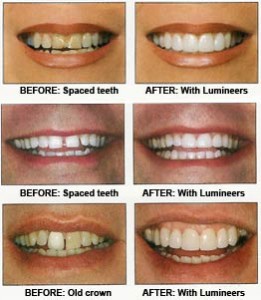
Before and after of dental veneer treatment @ websiteoptimization.com
Dental veneers are thin porcelain or resin composite material custom made to be bonded onto the surfaces  of your teeth to change their color, size, alignment, shape and length.
Procedure
The front part of the tooth has to be trimmed down a little to allow the veneer to be bonded. Porcelain veneer is more aesthetic than resin composite veneer as it is stain resistant and it mimics actual tooth due to its light reflection qualities.
Who needs it?
People with
- Uneven discolored teeth
- Chipped or fractured teeth
- Crooked teeth
- Heavily filled teeth
Cost
Generally, a dental veneer costs $500 to $1500 depending on areas, materials used and complexity of cases.
Caveat
Veneers are not as strong as dental crowns. You should not bite hard objects with your veneered teeth. If the porcelain veneer cracks it could only be replaced and not repaired. The color of the porcelain veneer never change, so if you plan to do teeth whitening please do so before having a dental veneer.
Denture vs Implant
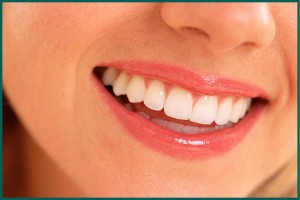
Picture taken from interfaithdentalclinic.com
When we have a missing tooth or teeth, dentist would always recommend denture, implant or dental bridges to replace the missing tooth or teeth. The cheapest way would be denture followed by dental bridges. Placing an implant would be the most expensive method but has the longest longevity claimed. Continue reading
Denture Implants
What are implants?
Dental implants are artificial titanium tooth roots that are placed in the jaw bone for the purpose of restoring lost or deficient function.
Dental implants are usually performed under local anesthesia by an oral surgeon specializing in implantology. Many implants system are available and many factors need to be considered when making a choice.
